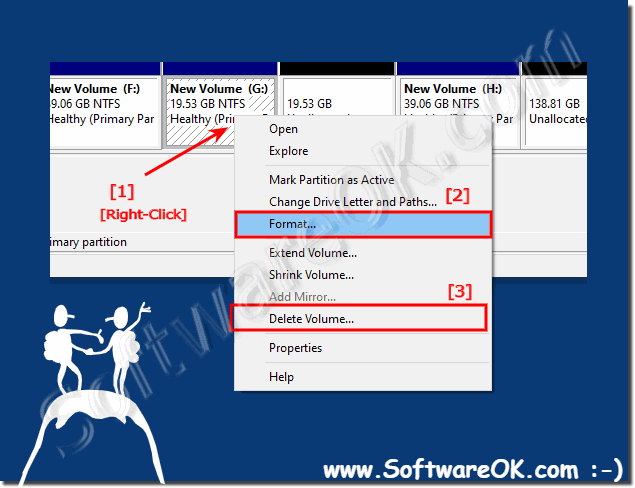NTFS stands for NTFS file system and is a file organization system used for formatting on Microsoft Windows 11, 10, ... etc. and other MS Server OS!Contents: 1.) ... NTFS file system as a file organization system!
|
| (Image-3) Format or delete Windows 10 Volume on SSD or HDD! |
 |
2.) NTFS offers advanced security features with file and folder permissions!
NTFS stands for New Technology File System and is a file system format used by the Microsoft Windows operating system to organize and manage files and data on storage devices such as hard drives, solid-state drives (SSDs), and external storage devices. It was first introduced in 1993 with Windows NT 3.1 and has since become the default file system for all modern versions of Windows, including Windows 10 and Windows Server.
NTFS offers several advantages and features compared to its predecessor, the FAT (File Allocation Table) file system, including:
File and folder security:
NTFS provides advanced security features, including file and folder permissions, encryption, and access control lists (ACLs). This allows granular control over who can access and modify files and directories.
File compression: NTFS supports file compression, which can save disk space by reducing the size of files and folders.
►► What is lossless compression?
File and disk quotas:System administrators can use NTFS to implement disk quotas to limit the amount of disk space that users or groups can consume.
Reliability: NTFS is a journaled file system, which means it stores all changes made to the file system (journal). This journal helps ensure the integrity of the file system and makes it more resilient in the event of power outages or system crashes.
Large file and volume support: NTFS supports very large files and volumes, making it suitable for modern storage needs.
Long filenames:Unlike older file systems such as FAT16 and FAT32, NTFS supports long filenames of up to 255 characters, allowing for more meaningful and descriptive filenames.
Unicode support: NTFS supports the Unicode character encoding standard, which allows file names and folder names to be handled in various languages and character sets.
►► What is Unicode and do I even need Unicode?
Sparse files: NTFS allows the creation of sparse files. These are files that can efficiently store empty or zero-filled blocks of data without actually consuming disk space until data is written to them.
Hard links and connection points:NTFS supports hard links and connection points. These are advanced features for creating multiple directory entries (links) to the same file or folder, as well as creating symbolic links to other locations in the file system.
►► What does hard link mean?
Info:
Overall, NTFS is a robust and feature-rich file system that meets the needs of modern computing environments. It is suitable for both personal and corporate use and offers advanced data management, security and reliability features.
Overall, NTFS is a robust and feature-rich file system that meets the needs of modern computing environments. It is suitable for both personal and corporate use and offers advanced data management, security and reliability features.
FAQ 254: Updated on: 7 October 2023 06:19
